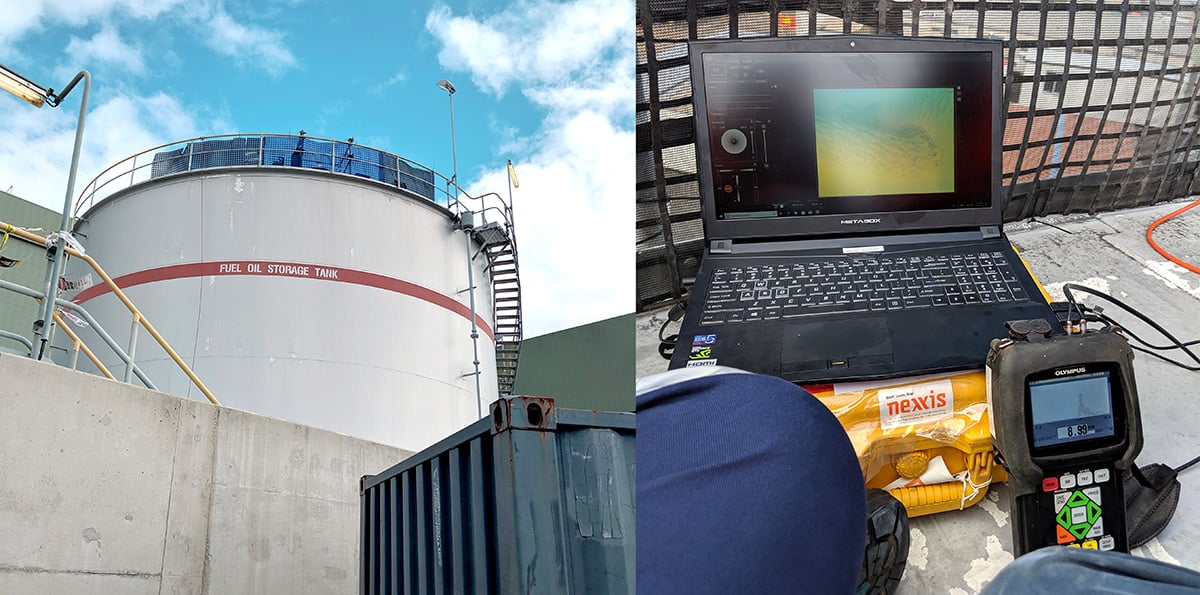Case Study: The Fastest, Cheapest & Reliable Diesel Tank Inspection on Record

Carrying out diesel tank inspections has historically been a lengthy and expensive task. From loss of revenue through to extended shutdowns and the risk involved to human inspectors, finding a better method has, until now, remained an elusive dream.
The following case study looks at a new innovation using cutting edge technology that’s proving to offer a game-changing solution.
The Challenge
There’s no secret as to the many problems faced when organising vital diesel tank inspections. In this case study, carried out at an oil depot in Switzerland, there was a need for 17 tanks to be surveyed as part of the legally-defined maintenance program. The tanks were old, having been built in the 1960s, with an expected lifespan of 50 years. Their longevity had exceeded this, meaning a requirement for frequent inspections every 3-5 years.
Up until now, internal inspections had been carried out by building 20 meter high scaffolding around each tank and inspectors entering to carry out visual inspections. This, of course, involved emptying the vessels to make them safe for human entry.
The whole process takes around two weeks when carried out in this traditional manner.
The Difficulties and Dangers of Manual Inspection
Such an inspection is fraught with multiple risks and other issues:
- The danger of working at height, even though inspectors are attached to ropes for safety
- Working in close proximity to volatile materials. Despite wearing explosimeters during their time in the tanks, inspectors are still at high risk as quick evacuation is difficult once on top of the scaffold
- The cost of preparation work is high, with the cost of erecting a scaffolding alone coming in at around $35,000 USD. There are also the additional costs of hiring qualified inspectors and equipment, plus the loss of revenue during a 2-week shutdown
The Solution? Remove the human aspect and reduce inspection time to mere hours
Despite many efforts over recent years to create a valid alternative to the above scenario, until now this hasn’t been possible to achieve.
The solution to the challenge was to use the Elios 2, an inspection drone created by Flyability specifically to address all of the issues of confined space inspection. This advanced, simple to use, tool has been designed to fly where no other drone can, inspect beyond the line of sight and have complete collision resilience.
Using the Elios 2 and with only minimal support from a drone pilot, oil depot inspectors were able to remotely inspect the complete internal area of each tank. Using a live video feed they benefited from high definition, close up views of the walls, welds, floor and roof – so producing an in-depth and accurate inspection report.
Some of the features of the Elios 2 include:
- High image quality: The drone is fitted with a 4K camera, allowing for close up inspection that far exceeds what had been managed in the past
- True stabilisation: Thanks to GPS-free stabilisation, holding a steady position in front of inspection areas allows for a second-to-none viewing experience
- Distance lock: The ability to lock the drone at a chosen distance allows inspectors to follow welds accurately, knowing their view is not compromised by looking at it along its entirely from altering distances
- Advanced lighting: Uniquely, the Elios 2 has an oblique lighting frequency that mimics how a human inspector would use a torch to add depth and detail during an inspection
- Simple to use: The Elios 2 is designed to allow anyone to fly it following simple, initial instruction
The Outcome
Despite the oil depot employees lack of experience flying drones, the ease of use of the Elios 2 meant that they were able to carry out the inspection with minimal intervention from the overseeing drone pilot.
The benefits of inspecting this way can be summarised as follows:
- The inspection time was reduced from 2 weeks to just a few hours
- No requirement to build scaffolding
- No need to keep the tank empty for an extended period
- No risk to human inspectors
- Gaining meticulous inspection data in a matter of hours that would take a person several days to reproduce
- A dramatic reduction in inspection costs – with the cost being a mere 4% of that of a manual inspection
All of the above means that the company is considering increasing the frequency of inspections and therefore extending the lifespan of the tanks.
Advanced technology, such as the Elios 2, is something that equipment provider, Nexxis, is dedicated to bringing to their customers. Novel solutions, such as this, are what makes the Nexxis model so unique, whereby they don’t simply supply inspection tools – instead, they consider the business needs and provide a bespoke and flexible resolution utilising proven tech to address company requirements.
Discover more about the Elios 2 Inspection Drone or contact us today for a no-obligation chat.
